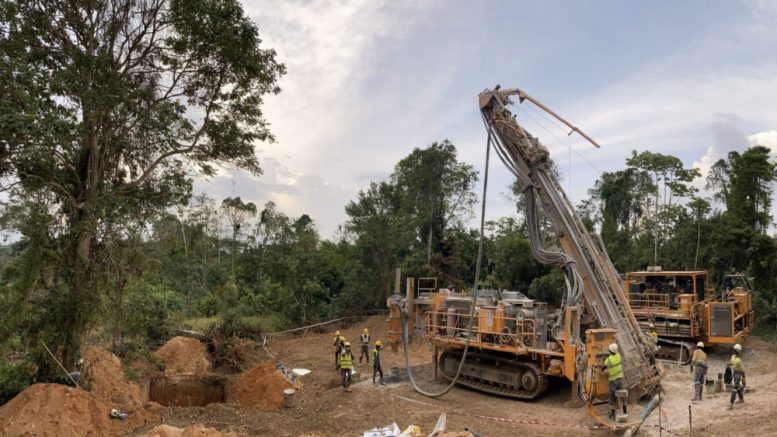Recent drill results from Newcore Gold’s (TSXV: NCAU; OTCQX: NCAUF) Enchi project in Ghana underlines the company’s district-scale exploration opportunity in Africa’s top gold producing nation, president and CEO Luke Alexander tells The Northern Miner.
On June 1, Newcore reported drilling at the Boin gold deposit, one of three resource-stage deposits comprising Enchi, had intersected 0.9 grams gold per tonne over 69 metres starting from 55 metres, including 2.06 grams gold per tonne over 12 metres from 61 metres, and 3.5 grams gold per tonne over 4 metres from 39 metres downhole.
These results are from a series of exploration holes designed to expand the gold mineralisation outside of the previously tested area by 400 metres to the north and one km to the south of the known deposit.
According to Alexander, these results have expanded the drill-tested strike extent at Boin to over four kilometres.
Boin is outlined on the surface by a greater than six-km-long by up to one-km-wide gold in soil anomaly. About 50% of the Boin surface anomaly remains untested to date.
The results continue to define a series of sub-parallel structures that include broad mineralised zones with higher-grade core structures, he says.
Alexander explains the gold mineralisation has now intersected at Boin along more than four kilometres of strike length.
The Enchi property contains several gold deposits, including Boin, Sewum and Nyam. Gold grades near the surface tend to be low, and the resource base has been calculated using pit shells with a maximum depth of 50 metres.
Like Sewum and Nyam, the Boin deposit remains open to further expansion along strike and at depth.

The Enchi project is on trend with some of Ghana’s most prominent mines. Credit: Newcore Gold.
The company had to date been using shallow (up to 200 metres depth) reverse circulation (RC) drilling to significant effect. RC drilling from August 2020, together with results from 2017-18 drilling campaigns, had resulted in Newcore calculating a 43-101-compliant estimate in October 2020.
“We’ve identified 25 targets today, of which we’ve only drilled on six, and those six make up our current 1.2-million-ounce resource,” says Alexander.
Enchi hosts 1.2 million oz. of gold in the inferred category in 52.9 million tonnes grading 0.72 gram gold per tonne. The resource estimate used a cut-off grade of 0.30 gram gold per tonne.
The company has chosen several high priority gold targets that could expand the near-surface oxide resources that the company expects will underpin a low-cost heap-leach operation.
Alexander estimates that across all the Enchi deposits, the company has delineated about eight km of strike length out of a prospective 100 km of defined structural controls on its 100%-owned property.
“Deeper drilling targeting 200 to 300 metres vertical depth is underway to better understand the depth extensions of these higher-grade shoots,” he says.
The Enchi deposits lie along one of West Africa’s most prolific and developed gold trends, the Sefwi-Bibiani gold belt. The Enchi project covers 216 sq. km along 40 km of the prolific Bibiani Shear zone, the setting of some of Ghana’s most successful mines.
Kinross Gold’s (TSX: K; NYSE: KGC) 5.5-million-oz. Chirano mine is about 50 km to the north and is one of several multi-million oz. deposits that, coupled with a stable and supportive legislative environment, have pushed Ghana to the top of Africa’s gold producers, according to World Gold Council data.
Alexander says Enchi shares the same geological features as Chirano but is up to five times more prospective, given its district scale.
“We’ve been spending all our effort on delineating the oxide and transition-style mineralisation for a conceptual starter project. However, the few holes that have been drilled deeper have intersected highly encouraging higher-grade sulphide mineralisation from 250 to 300 metres below surface,” he says.
“The Chirano mine hosts plunging zones of high-grade gold mineralisation with gold zones similar to Enchi,” he says. “Both properties exhibit numerous targets, with only six of 25 targets drilled to date at Enchi and never drilled at depth.”

Enchi shares the same geological features as Kinross Gold’s nearby Chirano mine, but is up to five times more prospective. Credit: Newcore Gold.
Newcore increased its 2020-21 drill program at the end of April to 66,000 metres, including an additional 8,000 metres of RC drilling.
As part of the expanded program, drilling this year will test extensions of defined deposits, retest previous holes that had no significant mineralisation, and complete first-pass drilling of anomalous zones on a one-km scale.
Newcore has recently reported some assays from its earlier-stage Kojina Hill gold target, with highlights of 59 metres of 0.79 grams gold per tonne from 61 metres downhole, including 10 metres of 3.03 grams gold over 10 metres from 80 metres.
Other work planned for this year includes metallurgical testing, geotechnical assessments, and a detailed topographic survey. Existing anomalies and targets will also be trenched and sampled geochemically.
Alexander says the company is “sharpening the pencil” to complete its upcoming project milestones by month-end. They include another resource update that will include an initial resource estimate for the previously drilled Kwakyekrom deposit and a preliminary economic assessment. These key catalysts could drive a substantial rerating of its equity.
Newcore has also attracted a top-tier roster of seasoned mining executives. “It is rare to find a board like this in the junior sector: billions raised, start-ups turned into producers and numerous major wins for shareholders,” says Alexander.
Newcore has a tight share structure with only about 99 million shares outstanding. Management and insiders own about 32% of the equity and the company has garnered strong institutional investors that account for about 35% of the float.
Newcore shares have gained about 10% in Toronto over the past 30 trading days to 65c apiece on June 3, which capitalises it at about $64 million.


Be the first to comment on "Near-term catalysts in the works for Newcore Gold as Enchi’s district-scale potential beckons"